Two Chop founder Mo Lam and AppAddictive CEO Mike Onghai were featured on an episode of Elevator Pitch, hosted by Alan Meckler, pitching their gamification venture, Two Chop. If you run a blog or other content oriented website containing text, music or images, Two Chop can take that content and turn it into a game in minutes.
The Value of Word-of-Mouth in Consumer Buying Behavior
Word-of-Mouth (WOM) is the primary factor behind 20% to 50% of all purchasing decisions. Its influence is greatest when consumers are buying a product for the first time or when products are relatively expensive (factors that tend to make people conduct more research, seek more opinions, and deliberate longer than they otherwise would). And its influence will probably grow because the digital revolution has amplified and accelerated its reach to the point where word of mouth is no longer an act of intimate, one-on-one communication. Today, it also operates on a one-to-many basis: that is, product reviews are posted online and opinions disseminated through social networks. Some customers even create Web sites or blogs to praise or punish brands.
Very interrelated to WOM is customer loyalty. Although the need to provide an after-sales experience that inspires loyalty and therefore repeat purchases isn’t new, not all loyalty is equal in today’s increasingly competitive, complex world. There are 2 types of loyalty: Active loyalists, who not only stick with it but also recommend it; Passive loyalists, who choose to stick to the brand either because of complacency or confusion caused by too many choices, and stay with a brand without being committed to it. Despite their claims of loyalty, passive consumers are open to messages from competitors who give them a reason to switch.
Some key concepts related to WOM
3 Main Classifications:
Experiential
WOM is the most common and powerful form, typically accounting for 50% to 80% of word-of-mouth activity in any given product category. It results from a consumer’s direct experience with a product or service, largely when that experience deviates from what’s expected. (Consumers rarely complain about or praise a company when they receive what they expect.) Complaints when airlines lose luggage are a classic example of experiential WOM, which adversely affects brand sentiment and, ultimately, equity, reducing both receptiveness to traditional marketing and the effect of positive WOM from other sources. Positive WOM, on the other hand, can generate a tailwind for a product or service.
Consequential
Marketing activities also can trigger WOM. The most common is what we call consequential WOM, which occurs when consumers directly exposed to traditional marketing campaigns pass on messages about them or brands they publicize. The impact of those messages on consumers is often stronger than the direct effect of advertisements, because marketing campaigns that trigger positive WOM have comparatively higher campaign reach and influence. Marketers need to consider both the direct and the pass-on effects of WOM when determining the message and media mix that maximizes the return on their investments.
Intentional
A less common form of WOM is intentional—for example, when marketers use celebrity endorsements to trigger positive buzz for product launches. Few companies invest in generating intentional WOM, partly because its effects are difficult to measure and because many marketers are unsure if they can successfully execute intentional WOM campaigns.
Measuring Word-of-Mouth Equity
A starting point has been to count the number of recommendations and dissuasions for a given product. There’s an appealing power and simplicity to this approach, but also a challenge: it’s difficult for marketers to account for variability in the power of different kinds of WOM messages. After all, a consumer is significantly more likely to buy a product as a result of a recommendation made by a family member than by a stranger. These two kinds of recommendations constitute a single message, yet the difference in their impact on the receiver’s behavior is immense. In fact, our research shows that a high-impact recommendation, from a trusted friend conveying a relevant message, for example, is up to 50X more likely to trigger a purchase than is a low-impact recommendation.
Loyalty Platforms and Social Loyalty Platforms
The growth of online social media networks such as Facebook, Twitter, LinkedIn, Pinterest, Instagram, Youtube has made online word of mouth a channel for businesses to acquire customers. Offering your customers membership to loyalty rewards club can incentivize your customers to spread positive reviews and experiences about your product. For the first time ever, merchants can have their loyal customers share their activity on Facebook to bring in new customers. The cloud based loyalty platform saves merchants IT costs versus existing desktop server solutions. Sign up today to learn how Social Loyalty can save you 88% on new customer acquisition cost. Visit SocialLoyaltyApps.com to learn more.
Social Loyalty Is The Next Big Marketing Strategy Of 2013
 In a recent SMB Digital Marketing 2012 held in Chicago sponsored by BIA/Kelsey SMB Digital Conference, one of the major headlines is that Social Loyalty is the Next Big Marketing Strategy of 2013. Social Loyalty Apps such as http://socialloyaltyapps.com/ convert “likes” into “leads” and leads into loyal customers. The chart below shows where small business owners are putting in their marketing budget.
In a recent SMB Digital Marketing 2012 held in Chicago sponsored by BIA/Kelsey SMB Digital Conference, one of the major headlines is that Social Loyalty is the Next Big Marketing Strategy of 2013. Social Loyalty Apps such as http://socialloyaltyapps.com/ convert “likes” into “leads” and leads into loyal customers. The chart below shows where small business owners are putting in their marketing budget.
According to eMarketer, the new report, “Social Loyalty: From Rewards to a Rewarding Customer Experience,” analyzes findings from dozens of third-party research providers and interviews with industry executives. Here are some of the best practices for improving social loyalty.
Why? Because many traditional loyalty programs are not highly effective, eMarketer notes. While loyalty programs have been popular in the US for years—with the average American consumer belonging to 18 loyalty programs according to loyalty marketing publisher COLLOQUY—it is not clear how many of these consumers are actually active.
eMarketer further notes that points, coupons and freebies are great for grabbing initial attention. But in the long run these promotions can’t make up for a lackluster customer experience. However, through the use of social media, retailers and brands can identify and interact with the most profitable internet users. And for the first time ever, social networks such as Facebook makes it easier for businesses to acquire new customers through social loyalty programs. Why? Loyalty can be won through encouraging word-of-mouth and creating advocates or evangelists, by raising a user’s social status, by surprising and entertaining shoppers in unexpected ways and also by listening to customers’ needs and suggestions and responding in a mutually beneficial fashion. Brands that most often succeed typically encourage sharing, raise customers’ social status, develop highly entertaining loyalty programs, and listen and respond to feedback quickly. Social loyalty programs provide brands with an unprecedented amount of customer data, both online and offline.
Basic Tips For A Successful Lead Follow-up
For companies looking to drive business online, lots of time and money is invested in lead generation. But what do you do when the leads start flowing in?
Though leads follow up may sometimes look daunting, successfully following up on a lead and starting the process that will take it to a sale doesn't have to be a trying and disappointing process.
Here are seven tips for following up on leads effectively.
1. Strike while the iron is hot.
In many cases, a lead is an asset that depreciates in value very, very quickly. Thus, it's worth trying to respond to qualified leads as soon as humanly possible. This is because your response time will often determine whether you close a sale or lose a sale you could have easily closed.
COMMON SENSE: it's important to read a lead so that you know who you're dealing with and what your opportunity may be. But the FACT: this doesn't always happen.
To avoid looking unprepared or taking things for granted, it is a tremendous help to create a checklist that your inbound marketers should use as part of the lead follow-up process.
3. Have the right (and preferably same) person respond and follow through from the get go to establish rapport.
To make the most of a lead, ensure that the person best capable of following up on it is the same person who responds. While new prospects may necessarily have to deal with several people throughout the sales cycle, it is often desirable to ensure that their first point of contact is someone they can start to build a rapport, if not a relationship, with.
4. Don't be afraid to pick up the phone
Thanks to technology, phone calls are more and more infrequent for many individuals, especially to younger members of the workforce. However, the phone is still a powerful sales tool and, if your lead contains a phone number, make a habit of picking up the phone and dialing it.
5. Get on the same page
When speaking with a prospect, walk before you run. Even if your lead came with a lot of detail, it's important to confirm that you have a good understanding of what the prospect needs and haven't made any assumptions that could unnecessarily limit your opportunity, or ruin it altogether.
6. Set expectations and timeframes
In every aspect of sales and business cycles, expectations are everything and it's never too early to set them. If an initial conversation with a lead confirms that there's an opportunity, take control. Once you're on the same page with the customer and understand his/her needs, you should at a minimum lay out what you think the sales cycle will look like. This includes proposing dates for key milestones.
7. Always respond
Not all leads are created equal. Some, unfortunately, are less-than-desirable for a variety of reasons. Nevertheless, assuming that the individual who submitted the lead is a real person, a response should always be provided no matter what. Not only can this help maintain your reputation in the marketplace, it also ensures that you will be remembered for future opportunities that may be a better fit.
12 Conversion Rate Optimization (CRO) Tips Based on Human Psychology and Behavioral Economics
First a disclaimer: Especially in social media, there are no such things as rules in conversion rate optimization. What works in one situation may not be the same for another.
Nevertheless, there are a number of hardwired human traits and behavioral patterns understood by psychologists, behavioral economists and other social scientists that we can use to increase our conversions. Our experience working with conversion rate optimization has given us some interesting insights as well. Contact us about conversion rate optimization for your web site or your organization!
Here are 12 brands identified by Econsultancy that used such principles and have worked. You might want to test them out yourself for your own brand and explore.
Social Proof
One of the most effective things you can bring to your site to increase the confidence of buyers is ‘social proof’. Social proof is the phenomena where people tend to believe that the decision and actions of others reflect the correct behavior in a specific situation. So, we have to create an experience which convinces our visitors they’re not the only person making this decision.
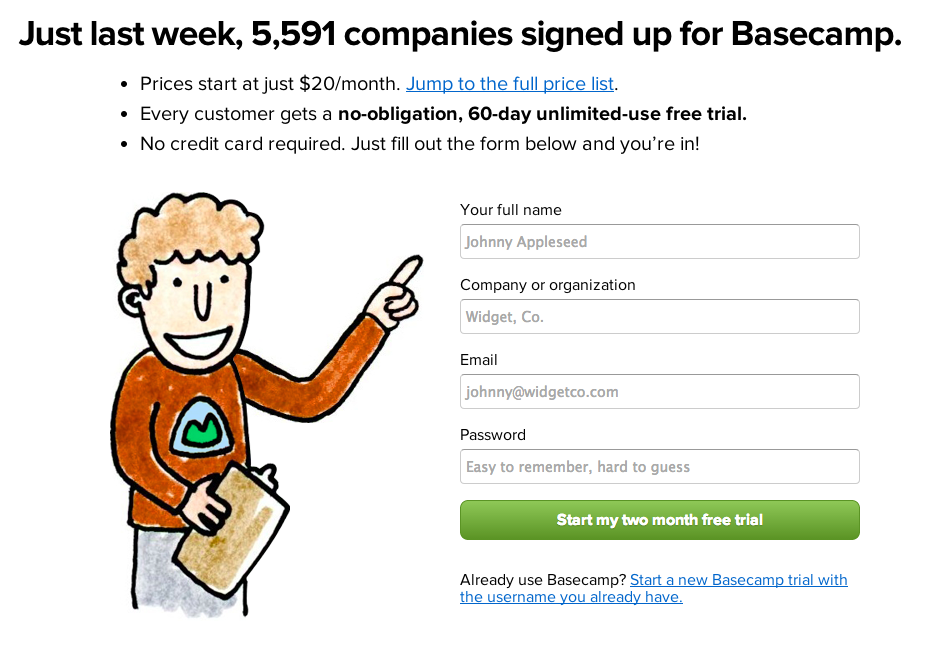
Basecamp Social Proof Techniques
Basecamp
In this design we see a prominent mention of the sheer number of other people who have made the same purchasing decision that the visitor is considering.
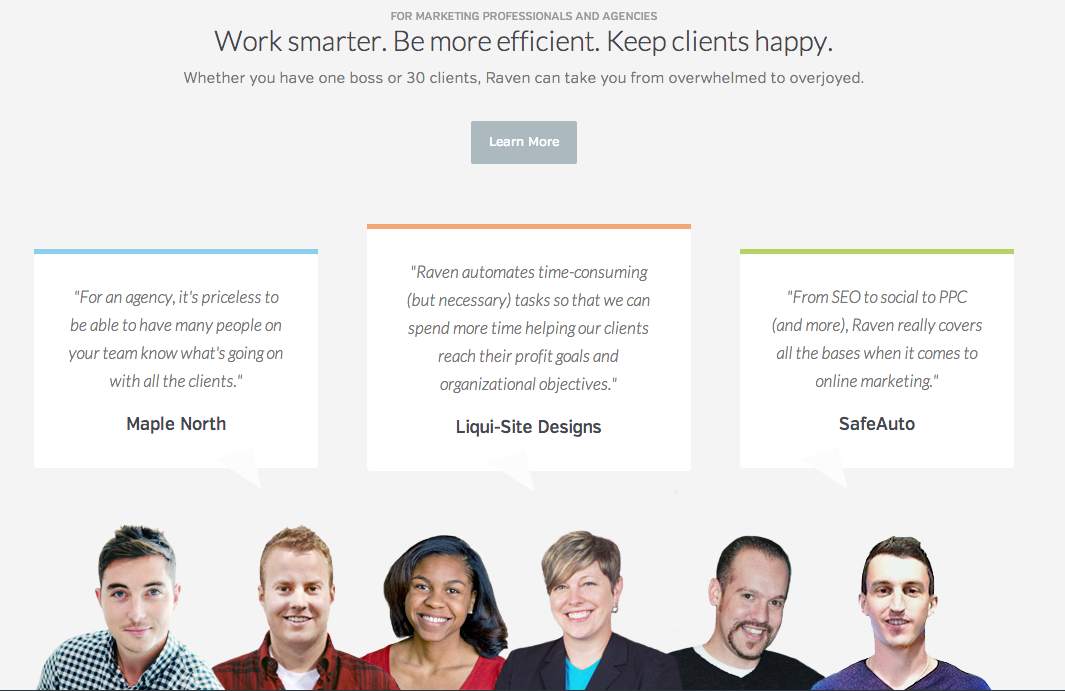
Raven SEO Tools
One of the most common ways to integrate social proof into your site is by including testimonials into your site, especially if you can include a picture of the person providing the social proof. Software as a Service (SaaS) companies are the kings of this. But it’s a sensible addition to most B2B sites and can also work well in B2C environments.

There’s a huge number of clever CRO techniques in place on this page but we want to highlight one of the easiest ways to implement social proof into your site, using the off-the-shelf Facebook Like button/widget. It really simply shows you the profile pictures of other people who’ve liked that page on Facebook, also prioritizing those who are connected the to the visitor of the site.
It is not just social proof, but personalised social proof. Actually it’s even better than that. It’s automated personalised social proof.
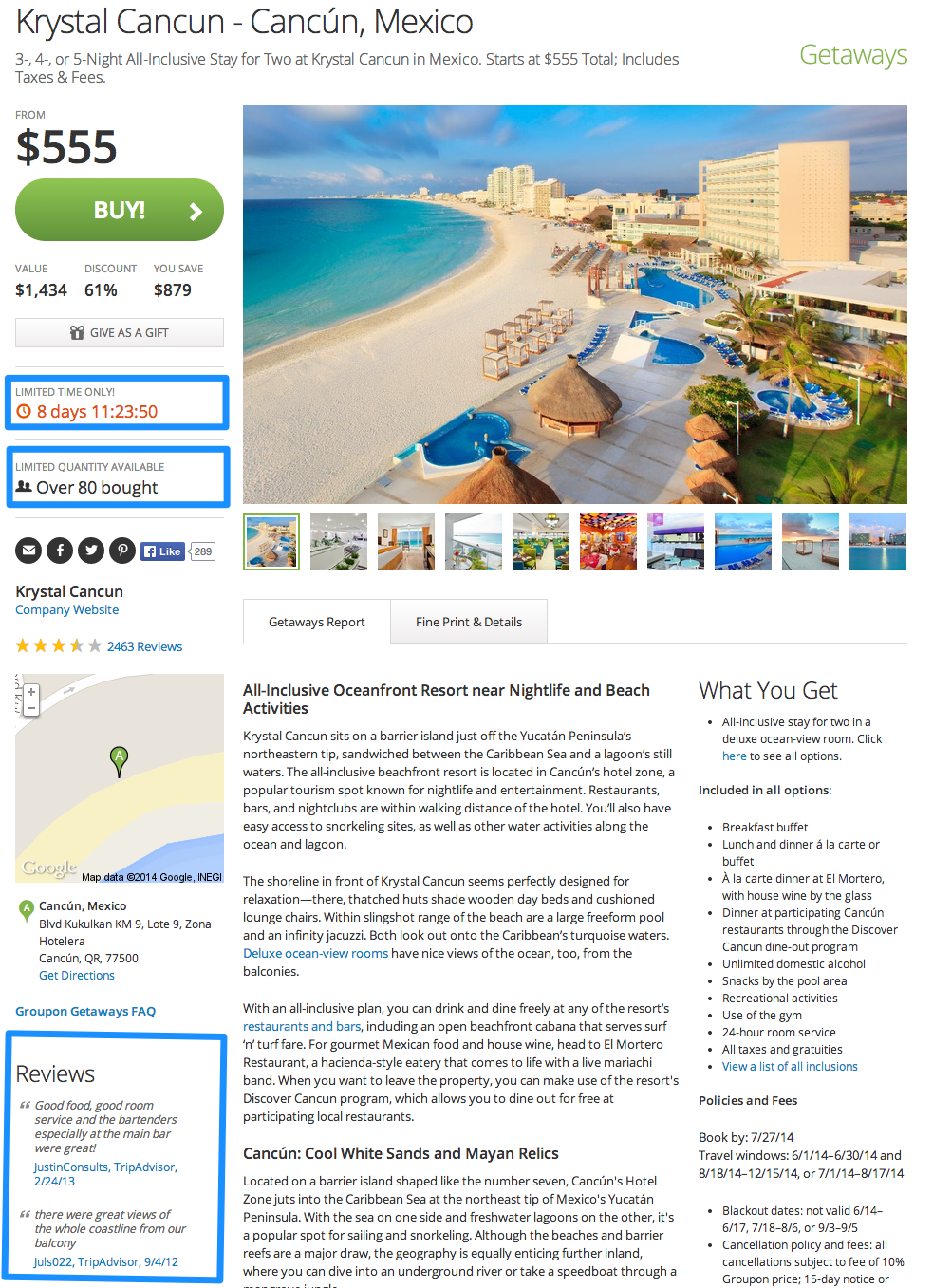
Groupon
Yes Groupon. It might have been getting a lot of stick recently but it, more than nearly every other major internet business, has a deep understanding of human behavior. Here it illustrates how they’ve built social proof into the very DNA of its business.
By showing how many other people have bought the same offer, Groupon hopes to persuade the visitor to do the same, and place an order.
Loss Aversion
The disutility of giving up an object is greater than the utility associated with acquiring it. This is known an Loss Aversion. ‘Disutility’ simply means that human tendency prefers not to lose something more than we love to gain something. Sometimes this is about a subtle re-framing of your copy to concentrate on loss rather than gain. We need to ask ourselves ‘How can we make visitors think they’d be losing something if they don’t buy?’.
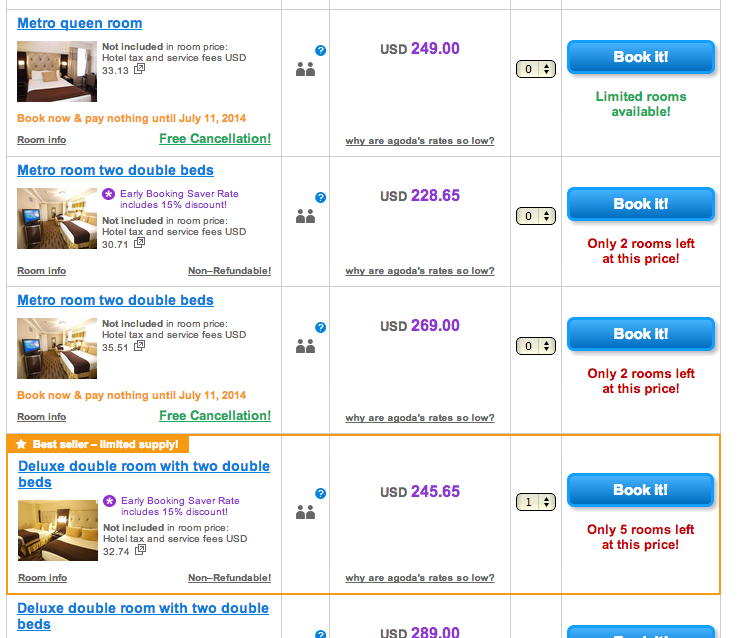
Agoda
Many travel websites are particularly good at communicating loss aversion. A good example is Agoda. It makes it clear what you would lose if you don’t book now. This serves to instantly increase urgency.
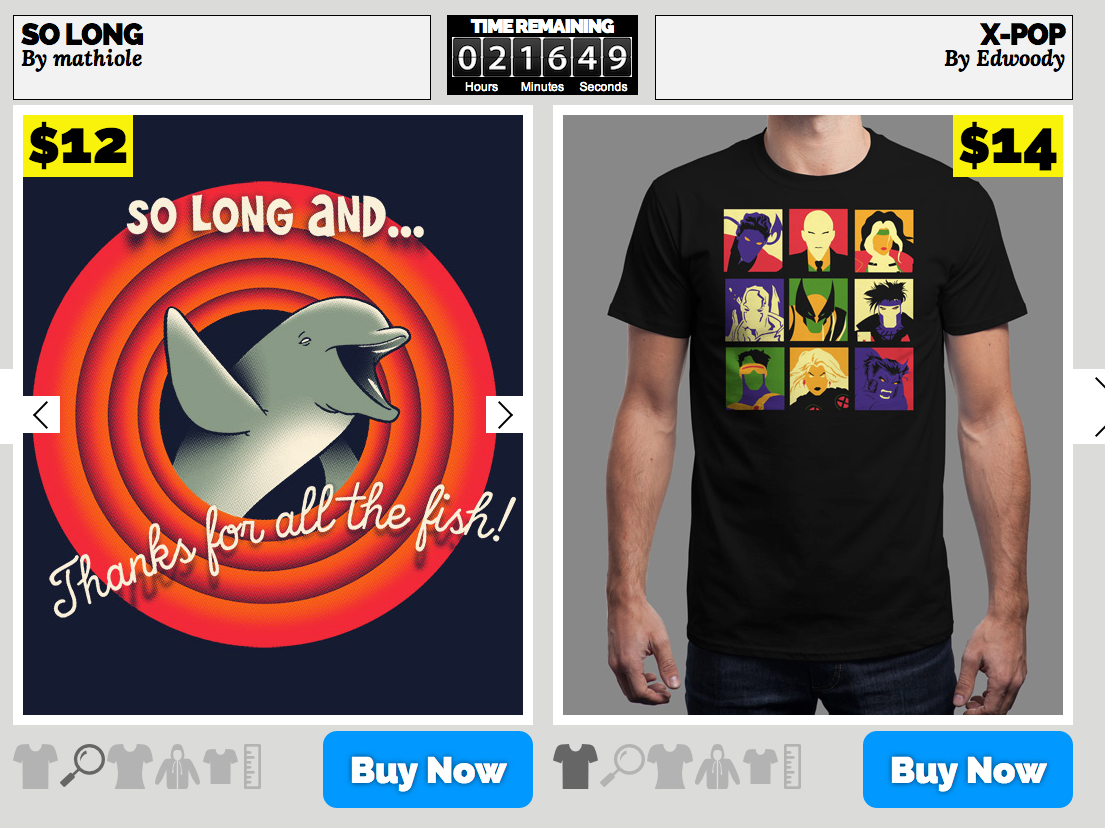
Qwertee
Qwertee has built an understanding of human behavior right into its business model. Its t-shirts are only available for 48 hours and after the first 24 the price increases. Every time you visit the site there’s a huge ticking clock showing exactly what you’re going to miss out on if you don’t purchase soon.
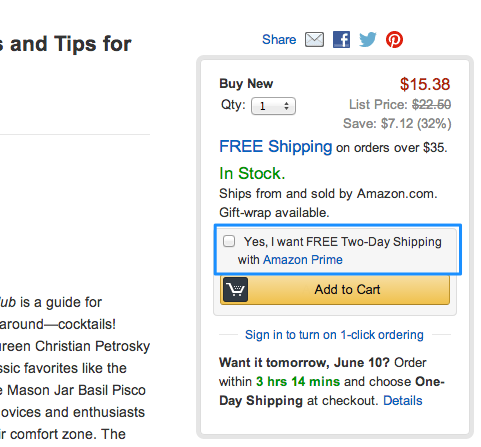
Amazon
Amazon is the king of using cognitive biases to increase conversion rates. One particular example where it uses loss aversion is for its ‘Prime’ customers. Prime users are a subset of their most frequent customers who have paid upfront fees to have access to next day delivery by default. If you’re a signed-in Prime customer, every product you visit that has next day delivery reminds you how long you’ve got before that day’s cut-off point.

Argos
It’s not just online giants like Amazon making use of our innate loss aversion to increase purchases. High street retailer Argos taps into our aversion to loss to drive footfall to its shops using this clever lightbox.
Anchoring
One of my favourite cognitive biases that influences the way behave, is known as anchoring. It is the tendency to rely too heavily – or ‘anchor’ – on a past reference or on one trait or piece of information when making decisions. These anchors can often be numerical. Our challenge is to ask ‘How can I reference an ‘anchor’ that influences visitors to my site?’.
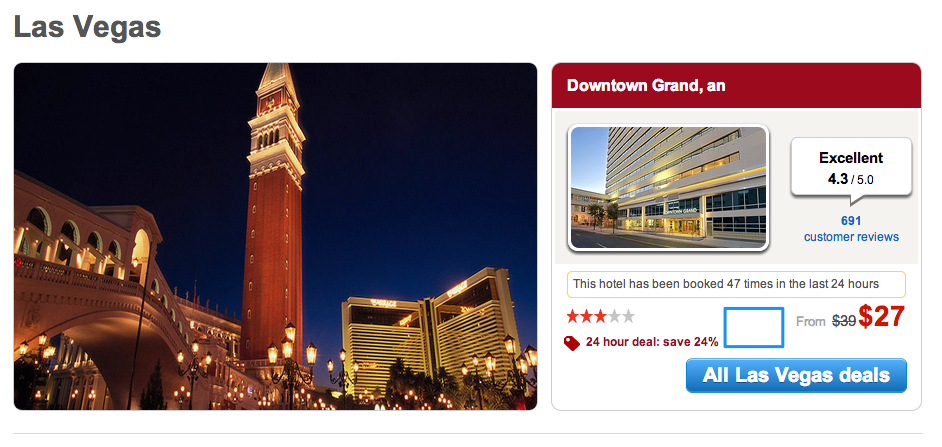
Hotels.com
One of the oldest anchoring tricks in the book is what the price was reduced from. Cross-hatched higher prices showing the available discount is a simple way to anchor the price of an item and make it seem better value.
Mailchimp
SaaS companies like MailChimp often make use of a clever anchoring technique that more businesses should be wise to try and use. You’ll notice they have one high price that’s much higher than all the other price points. This maybe be because it’s a popular option. However many anchoring experiments have found introducing one higher price point can lead to people spending more in total even if nobody chooses that option.
This concept is worth repeating because it is a bit counter-intuitive: Adding an extra expensive option to your page can increase the average order value of the page even if nobody selects that option. This is because it makes your other expensive options seem less expensive. This is one that’s well worth testing.
There’s also a case of possible anchoring taking place on the homepage of Broadband.co.uk, where the BT offer is significantly more expensive than the other options. That’s because the package is very different to the others. If we believe in the principle of anchoring, this may be increasing the value of the traffic to this page by encouraging them to assess the relative value of the other options differently.
Wiggle
Adding related products to a page can be a great way to increase the number of items people add to a basket. There’s also a possibility that the selection of these products might also have an anchoring influence. We don’t expect too many retailers bear price anchoring in mind with their related product algorithm, but it’s something you would expect some retailers to have tested.
As we noted at the beginning of this article, we don’t always know in every case that these changes have been implemented to increase conversion rates. However, if we understand human behavior and some of our cognitive biases, they would certainly seem worthy efforts to try.
Why Page Publishing Should be Your Business’ Core Competency
According to FB report, the best ads come from posts on your Page, so our best practices for Page publishing apply to Page posts and to ads and sponsored stories. Here are some Posting best practices recommended by FB:
Get the basics down.
Be succinct. Posts between 100 and 250 characters (less than 3 lines of text) see about 60% more likes, comments and shares than posts greater than 250 characters.
Post regularly. Post at least five times a week to stay top of mind for fans. Consistency is also key. For example, post new product announcements on the same day every week so fans know what to expect and can look forward to hearing from you.
Post at the optimal time. Only you know what’s right for your business, and you can use your Page Insights to figure out what’s working (for instance, try posting at different times of day and see when you get the most engagement). For example, FB reports show that restaurants post from 7am-12pm when people are making plans for the day, while retailers post in the 8am-2pm window. User engagement with Facebook Pages is highest from 9-10pm and the 18-24 demographic is the most engaged during this time.*
Be specific and relevant.
Know your specific audience. When posting to your page, your message will reach fans who are likely to be familiar with your brand, so insider content can make them feel in the know. To reach new audiences, you should create an ad from your page post and keep the content more general while still using your brand voice.
Be seasonable and timely. Fans are more likely to engage with topics that are already top of mind, such as current events, holidays or news. For example, posts mentioning Independence Day on July 4th generated about 90% more engagement than all posts published on that day.
* All engagement data and statistics are based on internal Facebook studies and represent average results.
Be relevant. For example, local businesses can reference community events, while national businesses can link to articles that their community will care about.
Make a visual impact.
Post photos and videos. Posts including a photo album, a picture or a video generate about 180%, 120%, and 100% more engagement than the average post, respectively.*
Use bold visuals. Grab your audience’s attention by using simple images with a clear focal point. Images with highly saturated colors also help the creative stand out against the site’s white background. An internal study showed that top performing ads (those with >.3% engagement in the form of likes, comments and shares) feature close-up images and a single color that stands out.*
Feature images that capture your brand. Ideally your profile image will be your logo or other brand symbol, but people should also recognize your brand in the images you feature. An internal study showed that when a brand was immediately identifiable in an ad, it performed better in terms of recall and purchase consideration.
Craft compelling content.
Speak from your specific brand voice. Include key words that are unique to your brand identity. If your brand has a fictional spokesperson, use their voice. If not, imagine how your brand would sound if it was a person.
Position your brand as a hero or problem solver. Highlight a specific product feature, such as anngredient or the convenience factor, and the impact it made. Reinforce this in the image if possible. An internal study showed that this was a characteristic of top performing ads.
Give fans exclusive access to content, products, events, and offers. Fans are 2x more valuable than non-fans, so you should reward them for their loyalty.* Take fans behind the scenes of events and product launches to make them feel special. Announce new products to fans on Facebook before anywhere else, give fans early access to sales, or post exclusive photos from events.
Deliver value to fans. Post limited-time offers or coupon codes, or use your Page to promote a sweepstakes or giveaway. Social loyalty rewards programs would make an excellent strategy.
AA Customer Spotlight: Green Square Growers
New York doesn’t have acres of land to grow fresh food. However, rooftop spaces can always be maximized to include growing fresh produce. Brooklyn Grange, the largest rooftop farm in NYC grows salad greens, rainbow chard, kale, basil, eggplant, cucumbers and ground cherries. This is one of the biggest projects funded by Mayor Bloomberg as part of the Green Infrastructure program that will help NYC become “a greener, greater city.”
Further down South (down under in Australia!) from where we call home is a group of like-minded individuals that share the value of going green through sprouting (literally) public edible gardens. Green Square Growers is an inspiring community that shares ideas such as how to create that strawberry vertical garden you never thought you could have as well as “how to green up your workspace.” Apart from their love and knowledge for gardening, they also know how to engage their community the right way. Let’s see how to do things the Green Square Growers way…
1. Who are the Green Square Growers?
We love growing food – at home and in public spaces. We are a local community group based in Green Square of Sydney, Australia and were founded in September 2011.
Basically we are all about sharing our knowledge of growing food with each other and others in the community. We also love installing public edible gardens that anyone in the community can access any time of the day.
2. How do you keep your community engaged, involved and excited to be a part of Green Square Growers?
We meet the 2nd Sunday of every month. Our meeting details are always shared on our Facebook page. Ironically our Facebook community is our local neighborhood community. We meet ‘offline’ to share knowledge, swap excess food produce, maintenance of the community gardens and to plan for future community gardens being installed. We encourage discussions to flow into the online space too.
3. Why did you create a Facebook brand page and why did you download the AA Static HTML app? How have these helped your organization?
We felt a Facebook page was a very simple way for the community to find out more about what we are doing and for our members to keep in touch with each other between catch ups.
We downloaded the AA Static HTML app to easily create a welcome page. We didn’t want a landing page as such (just happy for people to go straight to our wall). However once you arrive at our wall, you will be greeted with a large ‘hello’ button just under our cover photograph. The AA Static HTML app made it easy to create a multimedia welcome using text and video. This made it simple for people to know more about us and to inform them how they can get involved.
5. What advice can you give to other groups/organizations that want to succeed in their Facebook and inbound marketing efforts?
Encourage interaction online and offline and to take the time to welcome new visitors who click that wonderful ‘like’ button. Let people know your community group or business cares.
Optimizing Facebook Engagement: What Newsfeed Content Works
Every brand, product and target audience is different, so perfecting type of content is a unique process for each brand. While Tabs have played a significant role in how brands use Facebook to reach their customers, this blog points to a much deeper issue regarding any brand’s social strategy. Tabs are only part of the equation. The key lies in the quality content that continuously inspires genuine engagement.
The main hub on Facebook now between a brand and its fans is the newsfeed — the only place to reach a brand’s Facebook audience. To implement an effective strategy on Facebook, brands need ![]()
to engage more earnestly with their audience by focusing on content that breaks through the clutter. In turn, this compelling content heightens engagement and increases the likelihood that the Facebook Edgerank algorithm will incorporate these types of updates in the future. And for brands, this means knowing and thinking like their audience.
For starters, explicit calls to action get the best response. Here are other ways to tap into the mindset of a Fan, demand attention in the newsfeed and maximize engagement.
1. Establish connection with the Fans.
Once customers become Fans, brands need to remind them why they “liked” them in the first place. Insight on company culture, employees and events allows Fans to connect with a brand in a more direct and personal way.
2. Keep the message short and sweet.
Facebook users scan their newsfeeds multiple times a day. Multimedia updates that stand out next to long text blurbs tend to catch their attention and attract more comments, clicks and shares. Avoid text overload with visuals.
3. Set industry trends.
Fans like to learn more about the brands they follow and look to them for new ideas as a leader in their industry. Sharing white papers, interesting assets and positioning posts helps to showcase brands as thought leaders and set them apart from competitors. Use continuous newsfeeds to teach and inspire with leadership.
4. Be more than interesting – be helpful
Surprising Fans with interesting content that is not expected makes it fun, such as games, puzzles, etc. Nothing makes Fans more excited than accidentally finding something in their newsfeed that they were looking for.
5. Be relevant – a.ka. Be Local
Fans based in New York do not share common interests as fans in San Francisco. Facebook’s new promotion capabilities can unlock specific targets/markets. So use them wisely. Target updates based on personal location or interests. Share the right content with the right people to make your brand relevant.
6. Interact with your Fans in Real-Time
Social media allows brands not only to broadcast to their audience but to interact with them in real-time. Customers have now learned to use brand pages to express problems and concerns with the company. Hence, it has become even more important to address them in a timely manner. Positive experiences with customer service and extra help from brands build customer loyalty. These loyal customers create word-of-mouth marketing which, in essence, is free advertising.
7. Actually ask what Fans think
Opinions matter. Fans get excited knowing their opinions matter. The newsfeed is a great place to find out how Fans use a product or what they think about an issue through comments and polls. As they interact with a brand’s content, the newsfeed encourages their friends to chime in, as well.
8. Make your Fans feel special
Who does not like a VIP treatment? Fans appreciate knowing that they are valued. One way of showing their value is by giving away discounts, specials and exclusives on products and services just for Fans – This gives them incentives to try something new, and they would also spread the word about the exclusive deals to friends. Using a social loyalty program would be a good strategy, as well.
9. Lure your Fans back to the page
Fans need a reason to check out the “full view” of brand pages — and the newsfeed is a perfect place to do circle them back to the page. Promos, contests and engagement opportunities posted in the newsfeed are a great way to heighten interest and direct them to a brand’s Timeline or even a custom-designed application.
10, Create and Repeat
Facebook gives brands the platform to master the creation of compelling content, raise interest in Facebook content, inspire engagement, then better secure placement of future content in the newsfeed. And loop back again.
How to Make a Successful Facebook Conversion Funnel
The keys to leading a person from being a casual visitor to Liking a FB fanpage, and through making a purchase, depend on having a solid social strategy and compelling offers that get your community excited about. So how can your company make a successful conversion? Let’s go over some of the key factors and talk about how they can be applied to marketing on the world’s largest social network:
The Fewer, The Better – Liking with Limited Quantity
Scarcity is a powerful tool. Offering a product with limited time period or quantity can be very enticing. This is what drives impulse buys in social commerce. If your customers know they can’t get it anywhere else and there’s only a few left, they are much more likely to buy. Scarcity will attract new Likes (and customer acquisition) by word of mouth.
Quality Over Quantity
Popularity may be awesome but can be a tricky thing. A brand with 20,000 fans on Facebook is popular compared to one with 100 fans, but pales in comparison to the brand with 20 million fans. The real lesson is what you do with your fans and less about how many you have. So engage with your fan base and continue to offer a unique and awesome experience. In turn, your community will grow. The bottomline is that authenticity, consistency, and great content that generates a reaction are big drivers in developing a community. Posts with photos and powerful videos encourage sharing, and therefore expand a brand’s reach. An authentic brand voice will build trust, leading the casual brand fan to have a deeper sense of personal connection and ownership. This makes them pay more attention to your updates that appear in their news feeds.
Go Directly to Your Customers – Remove the Middle Man
So you have a community of fans. They are there for a reason – they like your products, your customer service, your stores, your marketing, etc. You are the authority on your brand and your fans want to directly deal with and buy from you. So take out the middle man and go directly to your fans. That way, you’re in control of the experience. Fans appreciate that direct experience much more than just buying your products at a big retailer. This is a big factor in the conversion funnel. People buy from the direct source because the sense of trust is very high. They know that the direct source cares more for the customers more than anyone else. Thus, a great social experience that ends with a sale builds affinity and is an opportunity for brands to build repeat business. The keyword here is “experience”. The experience flows all the way from the initial introduction to the offer through the message a person receives after the transaction. The experience ensures repeat customers.
Friends get Rewards
Reward your fans for being loyal to your brand and you can easily turn them into your evangelists or advocates of your brand or products. This is the beauty of the social loyalty program. You don’t only retain your existing customers. (Remember, new customer acquisition costs 8 times more than retaining your existing customers.) In essence, your evangelists give free testimonials and help you acquire new customers. You get free advertising. And for the first time ever, Facebook makes it so much easier to do word-of-mouth marketing and use existing fans to acquire new customers. Find what reward system works for your brand and make it a part of your overall strategy. It does not only drive down your costs, but it is a very effective marketing tool.
Be Consistent
The key to success in any endeavor is consistency – Show Up! When it comes to Facebook Commerce, you need to just stay on top of it. Your fan base is built over time. This can be accomplished in the form of polls, photo caption contests, giveaways, quotes, choosing a fan of the day, anything that engages your fans or get them involved. Facebook Commerce is about building a community. When used well, the Facebook conversion funnel is a loop. By being smart with the offer and providing a great experience along the way, you can build your audience’s expectation and make them shop through your Facebook page. So what else are you waiting for? It is right at your fingertips!
AA Customer Spotlight: Heason Events
Rock climbing, orienteering, skateboarding, and adventure racing are not seen in the Olympics but these exciting, sometimes grueling and tough sports, all have stories behind them– from the lives of the athletes to the terrains they seek and conquer, to reaching new heights (even literally) and milestones.
Who doesn’t love a good story? A story presented well has the power to be an art form. It can serve to inspire people, to make them understand something and to give them a call to action. Heason Events from the UK knows good story telling. They have successfully married the excitement of live lectures with the magic of big screen cinema into their events that adventurous spirits and minds always flock to. And thus, Heason Events carries over their expertise in storytelling to engage their community of enthusiasts using mediums like AppAddictive’s Vimeo and YouTube Gallery Apps on their Facebook Page as well as craft short messages via Twitter (@HeasonEvents). Let’s learn how to do things the Heason Events way!
1. What is the story Behind Heason Events?
Matt Heason launched Heason Events in spring 2003. It began life as a series of grassroots rock climbing talks in Sheffield. His aim was simple – to create slick, multi-media, digital presentations to excite, entertain and inspire audiences around the country.
Not long after, Matt started putting on the Best of Kendal Mountain Festival nights on at Sheffield’s Showroom Cinema. The evenings proved such a hit that in 2006 the Sheffield Adventure Film Festival was born. This year’s trailer had more than 100,000 hits and every year for the past 8 years 100% of visitors said they’d come again and recommend it to a friend.
Every summer, Matt partners up with Sheffield City Council to put on the UK’s biggest outdoors festival for outdoors folk – Cliffhanger. With more than 20,000 visitors the aim of the event is to inspire & involve. Featuring elite competitions and / or professional demonstrations in rock climbing, orienteering, mountain biking, running, slacklining, adventure racing and more, visitors are able to watch incredibly talented sports-people of all ages at the top of their game, and then take part in the very sports they have just been inspired by.
Matt also runs a successful speaker agency – his ‘Serious Adventure’ Speakers Portfolio is the most comprehensive network of serious (but not humourless!) adventurers, explorers and extreme sports athletes in the world. As he puts it, if the person you’re looking for is not on his list give him a call as he probably knows them or will be able to track them down.
Two years ago Matt teamed up with Lissa Cook – a former Radio 4 news journalist and PR. She’d moved to the Peak District to seek the good-life with her adventure sports writer and athlete husband, Nik Cook. Matt was impressed by the serious amount of media coverage she was generating for her handmade childrenswear business, Peak Princess, and got her on board.
It proved a dream team – with ShAFF ticket sales increasing by more than 75% in 2011 and another jump of nearly 50% this year and hundreds of pieces of press coverage.
2. How do you keep your community engaged and excited about your events? How do you keep people coming back to your events?
We “talk” to people & create a community of people who love adventure sports – we make sure we share plenty of great video content, interesting links to people we’re working with, products we’re reviewing, eye-catching images etc. We put a lot of effort in to responding via email, facebook and twitter so it’s a 2-way conversation.
3. Why did you create a FB brand page and why did you download the AA Vimeo app?
For a lot of film-makers Vimeo is a great way to share video content in high quality. Downloading the AA Vimeo app meant we can have a one click app where we share our Vimeo content.
4. What advice can you give to other businesses that want to succeed in their FB and inbound marketing efforts?
Don’t just broadcast what you’re doing – ask what your community of fans and followers are up to. Respond and react. Have fun. Share great quality content that fans in turn will want to share.












